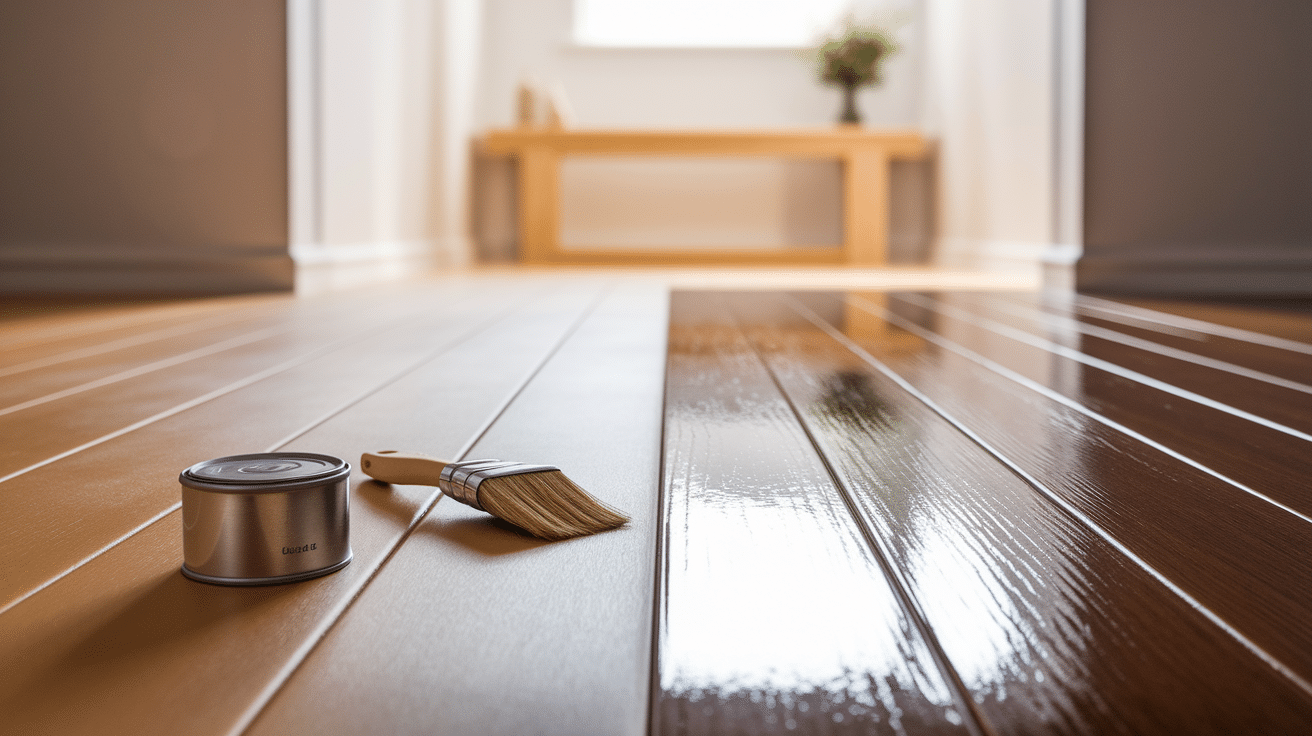“Should I go with satin or semi-gloss?” This question keeps many DIYers up at night. Make the wrong choice, and you’ll be sanding everything down to start over.
The choice between satin and semi-gloss polyurethane can make or break your project. Each option creates a completely different look and feel for your wood surfaces.
Satin offers that subtle, soft glow that many homeowners love. Semi-gloss brings a shinier, more noticeable finish that stands out. Both protect your wood, but they create very different moods in your space.
Let’s cut through the confusion and help you pick the perfect finish for your floors, furniture, or woodwork. By the end of this post, you’ll know exactly which can to grab off that shelf.
What is Polyurethane?
Polyurethane is a clear coating that shields wood from damage. Think of it as a plastic shield that keeps your wood safe from water, scratches, and daily wear.
It comes in two main types:
- Oil-based polyurethane – lasts longer and gives wood a warm amber glow
- Water-based polyurethane – dries faster and keeps the wood’s natural color without yellowing
People use polyurethane on all sorts of wood surfaces. You’ll find it on hardwood floors, kitchen tables, coffee tables, cabinets, and even wooden toys. Anywhere wood needs extra protection, polyurethane gets the job done.
The right polyurethane can make your wood projects last for decades instead of years. That’s why picking the right finish matters so much.
What is Satin Polyurethane?
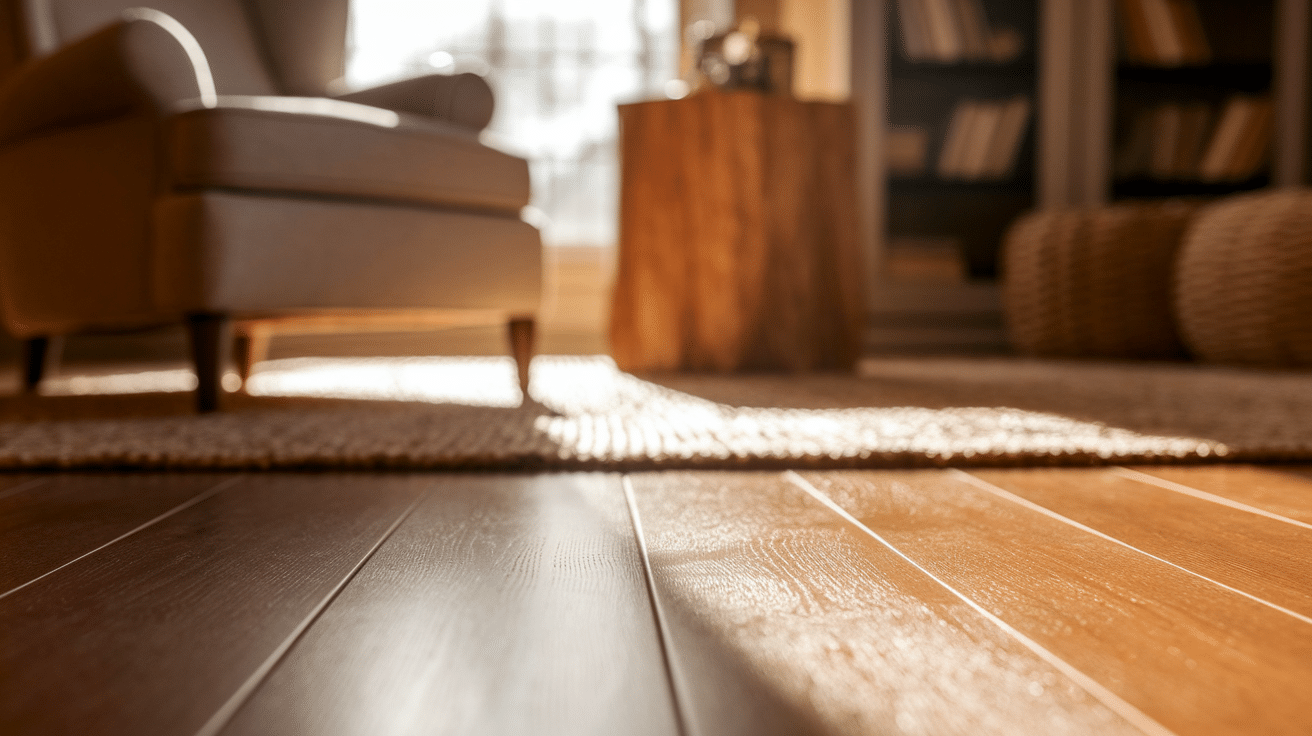
Satin polyurethane gives wood a soft, gentle shine. It’s not flat or dull, but it’s not glossy either. Think of it as a subtle glow that lets the wood’s natural beauty shine through.
Application
Satin finish works best on hardwood floors in living areas and bedrooms, dining tables and coffee tables that see daily use. It’s also great for cabinets and furniture that get touched often, plus wooden staircases and railings.
For the smoothest application, you’ll need a high-quality brush or applicator pad, clean lint-free cloths, and fine sandpaper between coats. Always work in a clean space with good air flow. Apply thin coats and sand lightly between each one for the best results.
Pros of Satin Polyurethane
- Hides scratches, dents, and dust better than glossier finishes
- Creates a warm, natural look that doesn’t distract from the wood
- Stands up well to fingerprints and paw prints
- Doesn’t show wear patterns as quickly as shinier finishes
- Gives rooms a cozy, lived-in feel
Cons of Satin Polyurethane
- Lacks the drama and light reflection of glossier finishes
- Can appear too muted in rooms without much natural light
- May need more frequent dusting to maintain its best look
- Doesn’t emphasize grain patterns as strongly as semi-gloss
- Can be harder to touch up if damaged in one spot
What is Semi-Gloss Polyurethane?
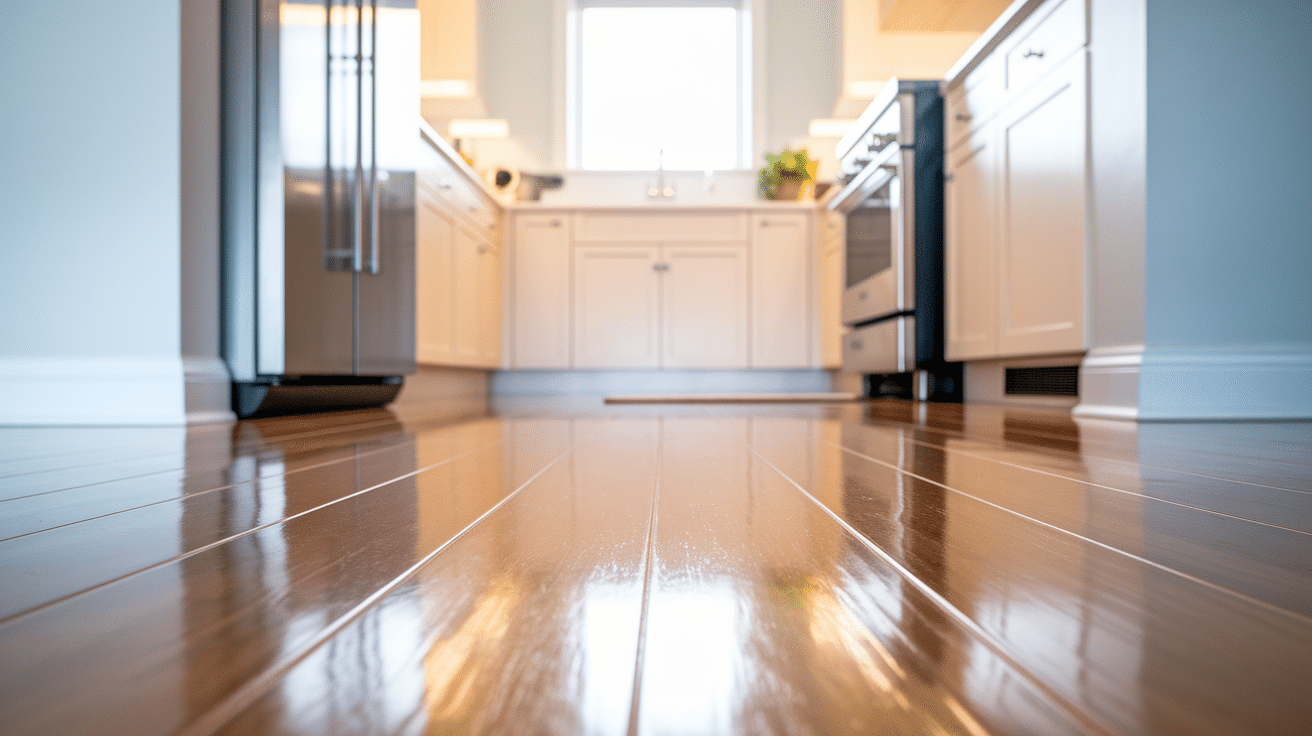
Semi-gloss polyurethane creates a shiny, reflective surface on wood. It falls between satin and high-gloss in terms of shine. This finish makes wood look more polished and brings out the grain patterns with greater clarity.
Application
Semi-gloss works perfectly in kitchens, bathrooms, and other areas that might get wet or see heavy use. It’s ideal for trim work, banisters, and furniture pieces you want to stand out in a room.
When applying semi-gloss, work in a dust-free environment and use long, even strokes. It typically dries to the touch in 2-4 hours, but wait at least 24 hours before light use. For best results, allow a full 72 hours before placing heavy items on the surface.
Pros of Semi-Gloss Polyurethane
- Creates beautiful light reflection that brightens spaces
- Cleans up easily with just a damp cloth
- Offers excellent protection against moisture and spills
- Resists staining better than less shiny finishes
- Makes wood grain and color appear richer and deeper
Cons of Semi-Gloss Polyurethane
- Highlights every scratch, dent, and imperfection
- Shows dust, fingerprints, and smudges more obviously
- Can create distracting glare in rooms with lots of windows
- Makes flaws in the wood more noticeable
- Can look too formal or artificial in rustic or casual spaces
Satin vs Semi-Gloss Polyurethane: What’s the Real Difference?
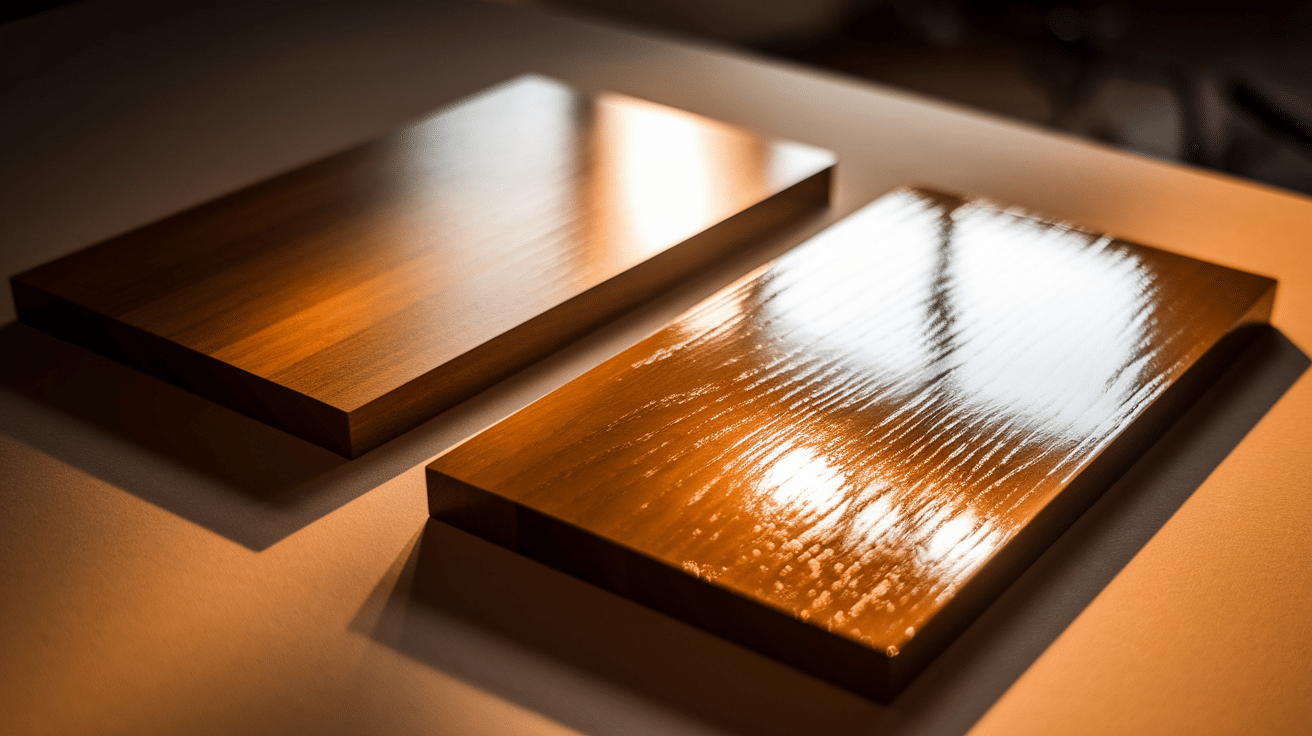
Let’s break down exactly how these two popular finishes compare so you can make the best choice for your project.
| Feature | Satin Polyurethane | Semi-Gloss Polyurethane |
|---|---|---|
| Shine Level | Low-medium shine (30-40% light reflection) | Medium-high shine (55-70% light reflection) |
| Appearance | Soft, subtle glow that looks natural | Noticeably shiny surface that catches the eye |
| Hiding Flaws | Excellent at hiding scratches and dents | Shows imperfections more readily |
| Cleaning | Requires more frequent dusting | Easier to wipe clean with less effort |
| Best Rooms | Living rooms, bedrooms, offices | Kitchens, bathrooms, entry halls |
| Durability | Good resistance to wear | Slightly better protection against moisture |
| Application | Forgiving for DIYers | Shows brush strokes more easily |
| Touch-ups | Blends in fairly well | Touch-up spots may be more noticeable |
| Cost | Similar price range | Similar price range |
| Drying Time | 24-48 hours between coats | 24-48 hours between coats |
Which is Better for Hardwood Floors?
The right finish for your hardwood floors depends on several key factors that are unique to your home and lifestyle.
Factors to Consider
Foot Traffic: For busy households with kids, pets, or frequent guests, satin is often the better choice. It hides scuffs and scratches that happen with heavy use. Semi-gloss can work well in less-traveled areas like formal dining rooms or guest bedrooms.
Lighting: If your room gets lots of natural light, semi-gloss can create beautiful reflections but might cause glare. Satin offers a more subdued look that’s easier on the eyes in bright spaces. For darker rooms, semi-gloss can help bounce more light around.
Home Style: Modern and contemporary homes often pair well with semi-gloss floors for that clean, sleek look. Traditional, farmhouse, or rustic styles typically look more authentic with satin finishes that don’t compete with other design elements.
Maintenance Habits: Be honest about your cleaning routine. If you don’t have time for frequent dusting and polishing, satin hides dust better. If you enjoy keeping surfaces spotless, semi-gloss will reward your efforts with a beautiful shine.
Recommendations for Different Homes
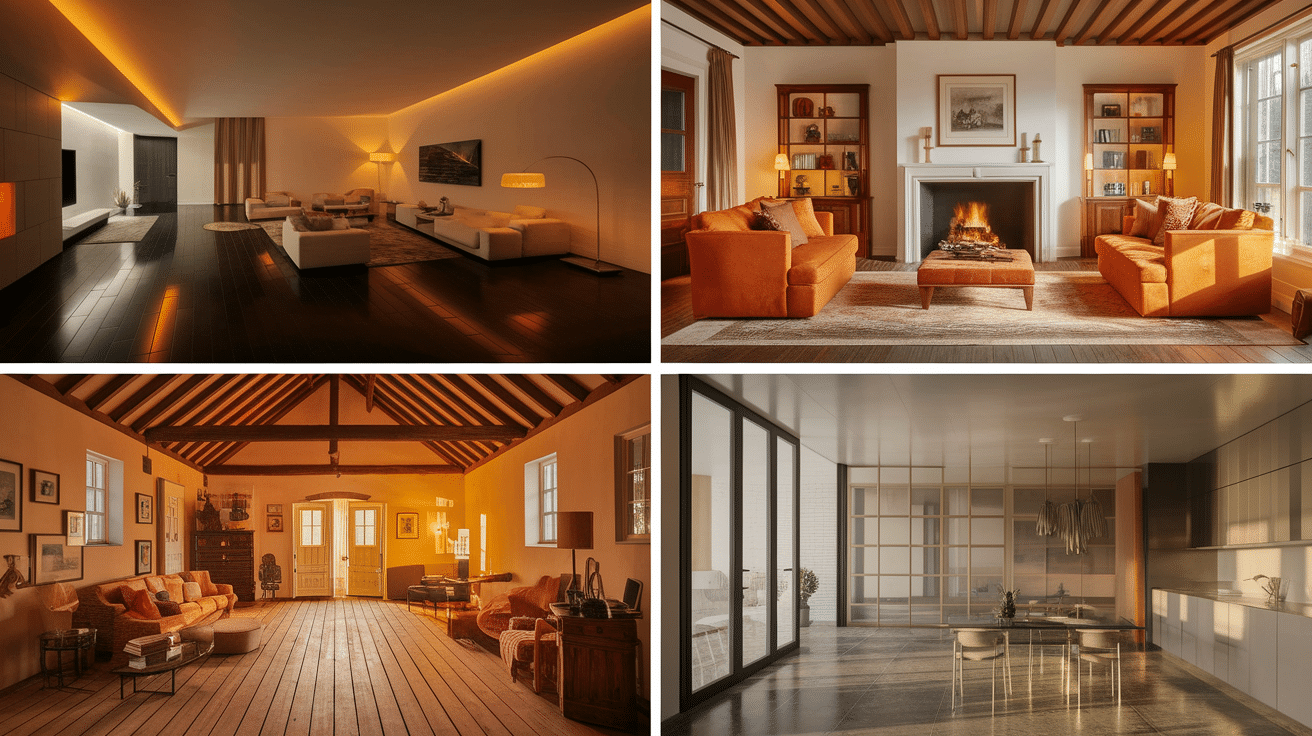
For Modern Minimalist Homes: Semi-gloss on dark hardwoods creates dramatic contrast with white walls and clean lines.
For Traditional Family Homes: Satin on medium-toned woods offers warmth and practicality that stands up to daily family life.
For Rustic Farmhouse Styles: Satin on light or natural-colored woods enhances the casual, lived-in feeling without looking too polished.
For Small Urban Apartments: Semi-gloss can make limited floor space appear larger by reflecting more light.
Tip: “The best finish isn’t always about looks—it’s about lifestyle. Consider how you actually live in your space, not just how you want it to look in photos.”
Conclusion: Making a Final Decision
Choosing between satin and semi-gloss polyurethane doesn’t have to be stressful. Think about how you use your space, your cleaning habits, and the look you want to achieve.
Satin offers a forgiving, natural finish that works well in most homes, especially busy ones with kids and pets. Semi-gloss brings drama and shine that can elevate formal spaces and areas where moisture protection matters.
Ready to protect your wood with confidence? Head to your local hardware store armed with this knowledge, or order online today.
If you’re still unsure, buy small cans of both finishes and test them on scrap wood to see which one speaks to you.
Your perfect wood finish is just one project away!

